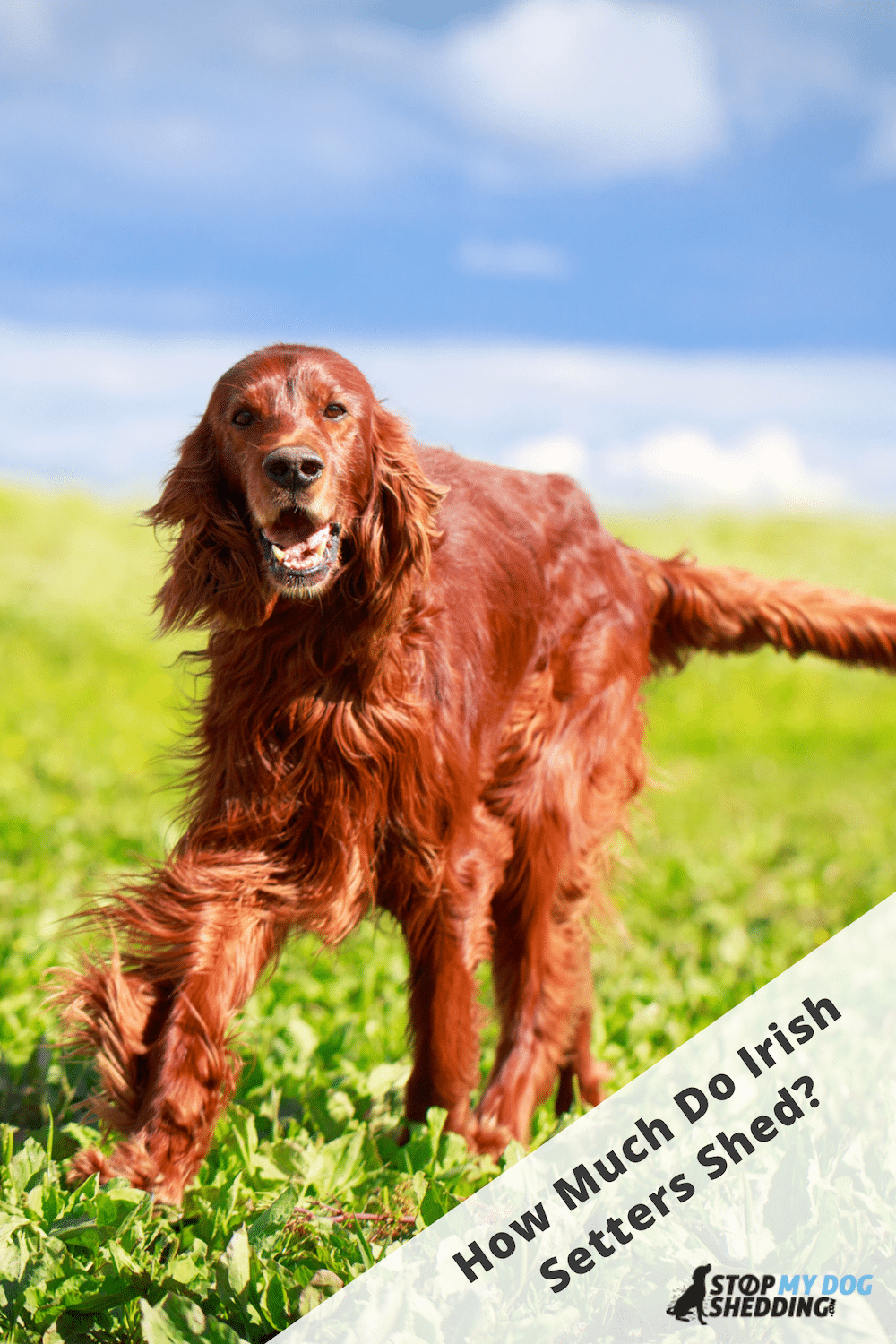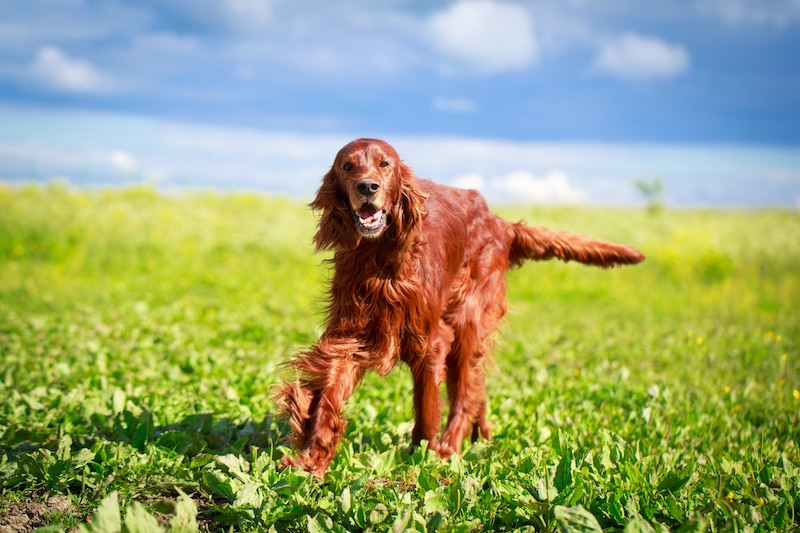The Irish Setter (Red Setter) is an elegant, energetic red-haired gun dog. They were originally bred by the Irish as bird hunters, but these days are better known as loveable family companions.
Do they shed much?
Irish Setters shed a moderate amount of hair year-round, and a lot during spring and autumn when their thick undercoat sheds more profusely. They make great companions but are probably not the best choice if you’re wanting a low-shedding, hypoallergenic breed.
In this article, we’ll explore how much hair they shed in more detail, as well as what they’re like to groom and what makes these red beauties so special.
Recommended: Go here to see our top-rated dog hair blow dryers
Irish Setter Shedding
Irish Setters are about average shedders, but like most dogs with a double coat, shed more during seasonal changes like spring and fall as they blow coat.
Given the color of the hair (most commonly red) and its length (medium to long), the hair that does fall out will be more noticeable than other breeds with shorter, finer, lighter hair.
And because they’re a larger breed with more surface area compared to a smaller breed, they do lose more hairs overall. This is not to say that larger dogs have a higher rate of shedding than smaller dogs, they don’t, there’s just more hair to go around.
So this is definitely not the breed for you if you are looking for a low shedding breed. And, while very manageable, they do require some effort to groom, especially if you want to reduce the amount of fur floating around your home.
Recommended: Go here to see our top-rated dog hair blow dryers
What Are They Like to Groom?
Grooming your Irish Setter will require a moderate amount of effort.
To put this into perspective, you’ll put more effort into brushing them than a breed like the Rhodesian Ridgeback for example, but less than a Wheaten Terrier.
The reason they require some effort to groom has to do with their combination of long, wavy top coat and soft, thick undercoat.
Their top coat is made up of silky red, chestnut or mahogany hair that is fairly long in most parts, which means it is prone to matts and knotting. So you’ll need to regularly brush the top coat with something like a pin and bristle brush to keep it in good condition, as well as remove debris and tangles. Which is especially important given that they love being outside playing as often as possible.
When it comes to the undercoat, it’s worth using a deshedding tool because these reach down to the undercoat and pull out dead fur quite easily.
Brushing isn’t just a good way to remove the loose, dead hairs from your Irish Setter’s coat, it’s also a good way to help spread the natural oils of their coat all over their skin. Which can naturally help prevent dry skin, something that leads to excessive shedding if left unchecked.
So they might take a bit more work to groom given their coat, but overall it’s not very difficult and can make a huge difference to how much hair you find laying around the home.
Aside from brushing, it’s just a matter of keeping their teeth clean and nails trimmed, which is standard on most breeds.
Are Irish Setters Hypoallergenic?
No, Irish Setters aren’t hypoallergenic, which in this context is a term used to describe a dog that is less likely to cause a reaction among allergy sufferers.
The reason they are not hypoallergenic is due to the amount of shedding they do. The allergens don’t actually come from the hair itself, it originates from dried saliva and dander, which means dead flaky skin. What happens is these allergens attach themselves to your dog’s hair which, when the hair becomes airborne, can lead to allergies.
So, generally speaking, the less hair the dog sheds, the better they are for people who suffer from allergies. But at the same time, even hairless dogs and those that shed very little can cause issues. It’s just that low shedding dogs don’t spread as much dander because more of it stays on their body.
How to Minimize Irish Setter Shedding
All dogs shed, so there’s not really anything you can do to “stop” this from happening, but you can reduce it. And one of the best ways to do this is with regular brushing.
A regular brushing routine of at least 2-3 times per week, or more when they’re blowing coat, helps to remove the dead hairs from the source. And it helps to moisturize their coat, which can prevent shedding that originates from dry skin.
In addition, making sure your Setter is enjoying a healthy, well-balanced diet, exercise, and bathing regime is going to help. Just be careful not to over bath as this can lead to dry skin.
What Are Irish Setters Like?
Irish Setters are an active breed that loves to play outdoors and run in large open spaces. This also means they’re not the best dog to leave alone in the home, or in the yard, for hours on end.
Given their high energy levels and desire to be around people, they can become destructive and hyperactive in these circumstances. They may also bark excessively due to separation anxiety.
In any case, Irish Setters make excellent family companions and are generally good around strangers, children, and other dogs. They are known for being loveable, outgoing companions.
The only caveat here is that they can sometimes unknowingly be a bit boisterous around young kids and since they are hunting dogs, love to chase small animals, including cats. So early training and socialization is key, as with most dogs, to ensure they fit in well with the whole family.
The good news is they respond very well to training and given their intelligence are fast learners. So as long as you put the effort into training as a puppy, you shouldn’t have any issues.
Recommended: Go here to see our top-rated dog hair blow dryers
Where Do They Come From?
Irish Setters (AKA Red Setters) are an Irish breed that has been around since the 18th century. They were purpose bred bird hunters that helped the Irish catch and locate birds.
In time, they became known as “gundogs” because the hunters would shoot the birds. And, given their keen sense of smell, Irish Setters would sniff out the bird and “set down” on their stomach when the bird was found, alerting the hunter to their whereabouts.
They are thought to have originated from a mix of Pointers (like German Shorthaired Pointers), Spaniels (like the King Charles Spaniel) and other breeds of Setters, like the English Setter and Gordon Setter.
In 1875 they arrived in the United States, and shortly thereafter in 1878 were registered by the American Kennel Club.
Related Questions
Do Irish Setters Smell?
Irish Setters typically are not a smelly breed, but they can start to stink if you don’t groom and bath them regularly enough and they are prone to ear infections, which tend to stink.
Do Irish Setters Drool?
Like any breed, Irish Setters do drool at times, but generally not very much. They are considered a lower than average drooling breed.
Do Irish Setters Have Fur or Hair?
Irish Setters have a “hair like” top coat which is technically fur because, unlike regular hair, it stops growing and when it does, falls out. Their undercoat is made up of thick, soft fur.













Please note: By submitting a comment using the above comment form, you confirm that you agree with the storage and handling of your data by this site as detailed in our Privacy Policy.